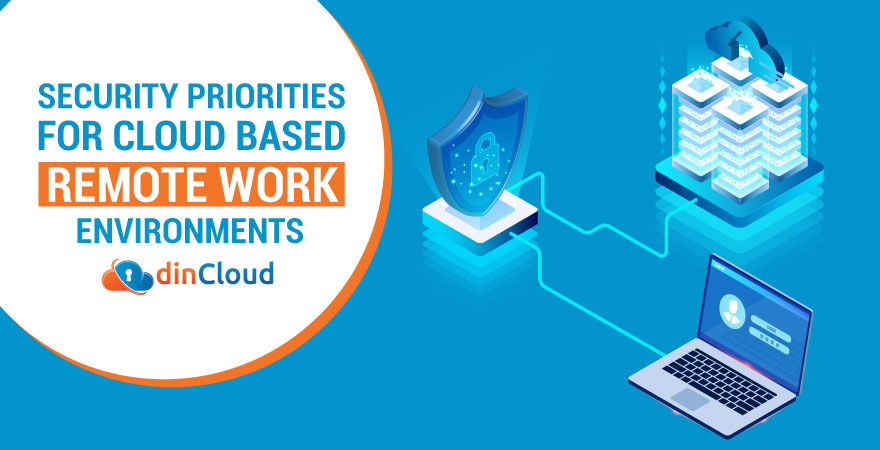In the present circumstances, remote work or working from home is rapidly becoming the new normal. The stats from recent reopening efforts across the globe have not shown very encouraging results. It seems the current pandemic and its effects are far from over.

As a result, even organizations that chose to remain passive so far in transitioning to remote work solutions are now doing so in a rush. When we look around for reliable and secure remote productivity platforms, the cloud based ones clearly stand out.
Also Read: 8 Reasons: Why Cloud Computing For Small Business?
Pitfalls of Hasty Cloud Transition
While the idea of migrating to the cloud is an excellent one, there are two very important caveats to this. Foremost is the process of selecting the right Cloud Service Provider (CSP) like dinCloud for your existing and future needs.
Secondly, this transition to the cloud should be after fully securing your existing IT infrastructure and assessing that of your cloud provider. The undue haste currently being observed in cloud migrations can spell disaster over the mid to long term.
Also Read: 6 Ways to Balance Remote Productivity and Security
Cyber Security Challenges in the Pandemic
The ongoing pandemic has brought along a host of cyber security challenges, in addition to the socio economic upheaval. Cyber miscreants are well aware that organizations are implementing remote work solutions in haste and thus, leaving gaps in security.
It’s these gaps in cyber security that bad actors in the cyber space are constantly in the lookout for. This presents a twofold challenge for IT teams, meeting strict timelines for setting up a remote work solution and also fully securing it from cyber threats.
Also Read: dinCloud Beefs Up Its Cyber Security Posture Amidst Covid-19
Shift in Attitudes towards Cyber Security
In traditional on premise environments, cyber security was considered the sole domain of IT and security experts. Dedicated employee devices would be sent to the IT department, where they were equipped with all the security protocols and that was all.
The present circumstances have completely changed how cyber security was perceived and achieved. Now, almost the entire company workforce is working remotely and in this scenario, every employee has to play an individual role in attaining cyber security.
A critical aspect of changing the perception and attitude towards present cyber threats is that each employee will have to act much more cautiously and responsibly. A seemingly routine email from one of your colleagues may actually contain harmful malware.
Also Read: How Cloud Service Providers Enhance Cyber Resilience?
Cloud Service Providers and Cyber Security
These are challenging times for Cloud Service Providers (CSP) due to a very hostile cyber security landscape. However, leading CSPs like dinCloud have risen to the challenge and not only kept their cloud infrastructures secure, but also beefed up security even further.
The very existence of CSPs hinges on keeping their cloud infrastructure and data centers at bay from cyber threats. Therefore, it comes as little surprise that cyber security is easily among the top most priorities for cloud providers like dinCloud.
dinCloud has invested consistently and heavily in both security tools and human capital to keep the valuable data and operations of its users absolutely secure. CPSs adopt a multi dimensional approach to cyber security and always remain ahead of threats.
Also Read: How to Safeguard Your IT Infrastructure from Brute Force Attacks?
Cloud Providers (CSP) and Compliance
In addition to the heightened levels of cyber security you enjoy with CSPs, regulatory compliance also becomes much feasible. Individual companies generally have neither the financial resources, nor the human capital to achieve full regulatory compliance.
Take the example of dinCloud, whose global data centers are independently certified for some of the leading international standards of physical and cyber security. In addition to many other benefits of the cloud, you also relieve yourself from regulatory woes.
Also Read: Spending on Cloud Infrastructure Grows by 37% in Q1 of 2020
Endpoints and Cloud Security
Most experts in the domain of cloud security firmly believe that endpoints are easily the most vulnerable part of any cloud infrastructure. Couple that with ill informed, uninitiated or negligent remote employees at your endpoints and this is a recipe for disaster.
The approach that with a CSP at your back, you no longer have to worry the least bit about cyber security can’t be farther from reality. In cloud infrastructures, even the best CSPs like dinCloud cannot fully secure the architecture without the cooperation of end users.
This can be achieved by improving employee awareness and conducting e-training of employees on how to use the cloud powered remote work infrastructure securely and responsibly. These simple initiatives can go a long way in improving overall security.
Dynamic User Authentication Solutions
Credential theft is becoming a menace over the cyber space. To contain the damage from this cyber threat, organizations that rely on cloud based remote work solutions must deploy a Two Factor (2FA) or Multi Factor Authentication (MFA) solution for their employees.
With 2FA or MFA at your back, even if a cyber miscreant gets hold of your employee’s “static” login credentials, the “dynamic” part required to complete a login process will still remain far beyond the reach of such bad actors.
Being an industry leading Cloud Service Provider (CSP), dinCloud has already integrated a strong 2FA solution for its existing cloud users as well as prospective ones. Both 2FA and MFA go a long way in protecting your cloud infrastructure from unauthorized logins.
Conclusion
In the present crisis and even for the near future, the Cloud is by far the most viable remote productivity platform when it comes to security, flexibility, agility and costs. What’s highly important though is selecting the right cloud provider such as dinCloud for your needs.
Contact Us for your remote workforce needs and dinCloud experts will design a solution that meets your existing as well as future productivity or connectivity needs.


